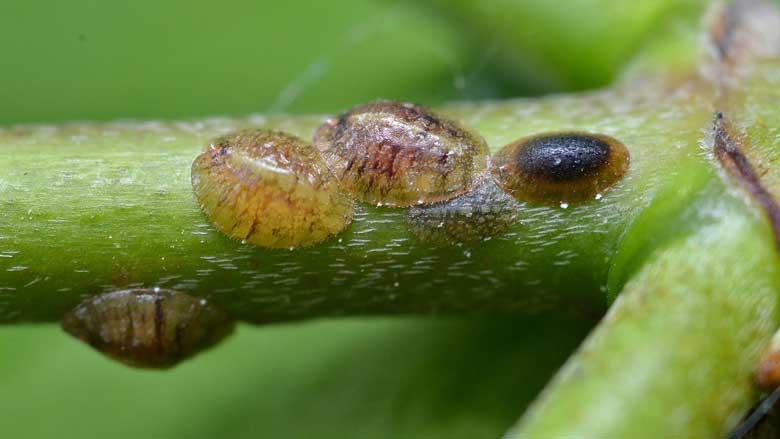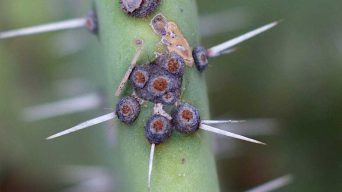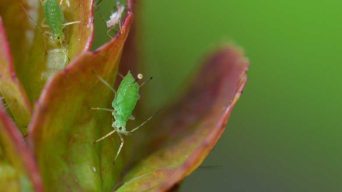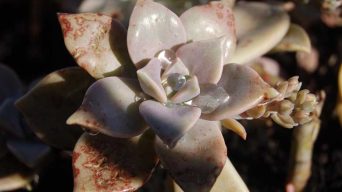Scale is a common problem for succulents. It’s easy to spot scale on your plant but difficult to get rid of it.
Scale is a scale-like insect that lives on the succulent and eats the sap. The scale sucks out this juice and causes damage to your plant.
The good news is that scale isn’t fatal, and there are ways you can stop scale from coming back!
This article will go over how scale forms, symptoms, prevention methods, and treatment options so that you never have scale on succulents again.
What Are Scale Insects
Scale is a scale insect, which resembles an oyster mushroom.
They are parasites that attach themselves to the stems of succulents and cut off nutrients from them, causing damage and eventually killing the plant if left untreated.
This scale feeds on a cactus or succulent by secreting a fluid called hemolymph, which contains water and high levels of sugars. This is what causes scale to appear shiny or sticky when you touch them.
They usually attach themselves in clusters but can spread out if left untreated.
A few different scale insects can affect succulents, such as the cochineal scale, but they all have similar life cycles and the same general symptoms.
Scale insects can cause damage to succulent plants.
It appears in the form of black spots or bumps, which grow until it covers an entire leaf. If left untreated, scale insects will continue to spread and affect more leaves.
Sometimes scale may appear underneath the soil surface when feeding off your plant’s roots!
You’ll know if there is scale under the soil because you’ll start seeing browning-looking patches around your base of the plant. It’s essential to get scale under control when you see it.
If left untreated, scale can destroy your succulent plant!
What Causes Scale on Succulents
Many things can cause scale to appear on succulents. Some of which include: stress, overcrowding, or overwatering your plants.
If you keep noticing scale appearing one after another, it could be because there’s a high level of humidity in the air.
If scale appears underneath the soil surface, then it may mean that your potting mix is too wet or water doesn’t drain appropriately from the saucer underplant.
Scale can also appear when you move your succulents to a new environment where scale insects are present.
It’s crucial to inspect these factors and resolve them before starting any treatment for scale insects on succulent plants, as they will only continue spreading without doing so!
What Does Scale Look Like on Succulents?
When the scale first appears, they are small black bumps that look dusty. When you touch the scale on succulents, it feels sticky and sometimes leaves a powder behind when the scale is removed from the plant.
As the scale grows older, it can turn brown or yellowish with red-tinted edges.
Sometimes the entire leaf will start turning pale after many scales feed off nutrients of your succulent leaves!
If left untreated for long periods, then scale may completely cover the surface area of your succulent, resulting in loss of energy which eventually kills off the entire plant.
So if you notice any symptoms of scale on succulent plants, be sure to act quickly before things get worse!
What Damages Does Scale Cause
Scale can cause damage to succulent plants in many ways.
Scale insects feed on succulent plants by draining nutrients from stems and leaves, resulting in the yellowing of the plant’s foliage.
In severe cases, scale can suffocate a succulent stem cutting off the life-giving water supply to the entire plant, causing it to wilt or die completely!
When scale insects feed off your plant’s leaves, they leave behind a sticky residue that coats the surface of foliage, rendering it unable to photosynthesize, which means scale is stealing nutrients from your plant.
Because scale cuts off energy supply, leaves begin losing moisture and will eventually wilt or die completely if scale is not removed. If left untreated for too long, then the entire affected succulent could turn brownish or even black!
If scale insects are left untreated, they can spread rapidly and eventually cover the entire plant in clusters, resulting in the death of succulent plants.
Scale is extremely harmful to succulents! If you notice any symptoms of scale on your succulents, be sure to act quickly before it’s too late, or else there could end up being significant damage done!
How To Treat Scale on Succulents
There are many ways scale on succulent plants can be treated.
Each method has its own pros and cons depending on what stage scale is at when you notice it, the severity of scale infestation, as well as how much experience you have with handling scale insects!
I always encourage people to try one or two methods first before trying any others because some methods may not work for certain types of scale.
Remember that prevention is always better than treatment, so take time to inspect your houseplants regularly, whether they be succulents or other indoor plants!
Method #1: Use Natural Predators For Scale Insects
What You’ll Need :
- Natural scale predators such as ladybugs, lacewing larvae and parasitic wasps.
Natural predators for scale are safe and very effective in getting rid of scale on succulents.
Many species of scale insects have natural enemies, which you can use to your advantage when trying to get rid of them! These include ladybugs, lacewings, parasitic wasps, and predatory thrips.
Ladybugs feed off-scale insect eggs, so if you want to release these bugs into your home, be sure that there is a large population of scale present because they won’t eat anything other than their prey – the scale insects!
Lacewing larvae are known as “aphid lions” since they love eating aphids (which are closely related to scale), while parasitic wasps lay their eggs inside scale insects’ bodies so their larvae can feed on scale from the inside out.
Predatory thrips are another predator that feeds off-scale, but unlike lacewing larvae which only prey on the young scale, thrips prefer to eat adult scale instead!
Method #2: Use Insecticidal Soap For Scale Removal
What You’ll Need :
- Spray Bottle
- Insecticidal Soap
Insecticidal soap is a natural insecticide made of potassium salts of fatty acids combined with water to dissolve fats and oils found in an insect’s body membrane.
This causes paralysis within minutes for insects that come into contact with this type of chemical spray!
When treating scale, fill up your bottle of cold water, add about a tablespoon of liquid soap, and shake well.
Then spray the scale directly while avoiding the succulent leaves as much as possible!
Make sure you don’t add too much soapy water since this can damage your plant rather than kill scale off, so always follow manufacturer directions when using insecticidal soap spray for scale removal.
If in doubt, then just dilute with water instead or ask a professional for help if needed.
Method #3: Use Neem Oil For Scale Removal On Succulents
What You’ll Need :
- Spray Bottle
- Neem Oil
Neem oil is another organic pesticide made from the neem tree which can be used to treat scale on succulents.
Since it kills scale insects by disturbing their hormonal balance, this method may take a little longer than other methods, but it’s safe for use around your home and family.
It will also not harm beneficial bugs such as ladybugs since these predators don’t feed off scale!
Dilute neem oil with water before using it and apply the solution directly onto scale infestation location, making sure that you target only the affected area; otherwise, plant leaves could end up getting damaged if they come into contact with neem oil mixture!
This type of pesticide should constantly be tested first in an inconspicuous area before using it to prevent damage to your succulent leaves.
Method #4: Remove Scale by Hand
What You’ll Need :
- Small Brush (to scale off the leaves)
This is another safe way to remove scale on succulents that can be done by hand. Use a small brush or toothbrush and gently scrub them away.
However, this method will not always work for scale since plant protectors like waxes may also need to be removed before scale can go.
If you have trouble getting rid of these succulent pests using this method alone, then I recommend trying other methods instead!
Method #5: Use Isopropyl Alcohol Spray For Scale Removal
What You’ll Need :
- Spray Bottle
- Isopropyl Alcohol (90%) or Rubbing Alcohol (70%)
Isopropyl alcohol is another method for scale removal on succulents.
Fill up your bottle with cold water, then add half a cup of rubbing/isopropanol into it and shake well before applying.
This solution will have to sit on a scale infestation location since the chemical reaction between these two types of liquids won’t happen instantly, so you can just place the sprayer down until scale insects are dead!
Then remove by hand if possible – otherwise, use gloves!
If some scale remains after waiting for this mixture to work its way through them, then reapply the same solution and give scale another chance to work or try using a stronger alcohol solution (70%) if you still can’t remove scale by hand.
This scale removal method will also work on mealybugs since they’re related insects!
How To Prevent Scale on Succulents
Succulent scale is a widespread issue for succulents.
The succulents scale has been reported as being so bad at times it covers much of their surface, preventing photosynthesis from happening effectively.
However, there are ways to prevent scale from growing and keep your plants healthy:
Repot Your Plants Regularly
Repotting succulents will help remove scale and allow them to eliminate any scale they may already have.
Replacing the soil every couple of years with the fresh potting mix will disrupt scale eggs and kill them before they hatch.
Water Your Succulents Appropriately
Succulent scale is especially common among succulents that have been overwatered because water allows the scale insects to survive much more easily in these humid environments.
Ensure that you only water your succulents when necessary and that the soil is well-drained.
Don’t overwater. Allow the soil to dry out completely between each watering.
Trim Scale Infested Leaves Off
If scale insects have already begun to colonize on succulent leaves, remove them immediately with sterilized pruning shears before they can spread any further throughout the rest of the plant or garden.
Keep Plants Dry in Winter Months
As scale prefers humid environments during colder seasons, it may help keep your succulent scale-free by not overwatering them in fall and winter, when they’re less likely to grow actively anyway due to cooler temperatures outside.
It may also help to move these indoor succulents away from heating vents where humidity might become an issue.
Remove Dead Leaves
Scale can be found in old leaves and ones that have fallen from the plant.
This is why keeping your succulent scale-free also involves removing dead or dying leaves, particularly at the base of a plant where scale tends to hide out more often.
This will prevent them from multiplying and keep scale insects away because they cannot survive in dry conditions.
Keep Plants Well Ventilated
Scale insects prefer humidity and can be discouraged by allowing succulents to dry between waterings.
Still, they also like it dark, hot, and humid inside the leaves of an enclosed plant pot or terrarium.
Providing adequate ventilation for potted succulents will encourage scale to seek out less favorable conditions.
Introduce Beneficial Insects Into Your Garden
Hoverflies, parasitic wasps, and ladybugs are just three natural scale predators that can be introduced into your garden to provide scale with some much-needed pest control.
This will help kill off scale insects before they have time to reproduce or colonize on plants.
Final Thoughts
Succulents may be infested by a variety of insects, including scale, mealybug, spider mite, aphid, and fungus gnat.
Scale on succulents is not something to fear. If you are experiencing scale, attempt one of these methods and see if it works for your particular situation.
Also, keep in mind that scale can be caused by several factors, including improper watering practices like overwatering or underwatering.
Make sure you are checking your succulents regularly for scale, so they don’t get worse! If scale becomes a significant problem, stopping or removing the infestation from spreading can be difficult.
Again, scale is not something to fear, and if you are experiencing an infested succulent, there are many ways you can get rid of scale!







